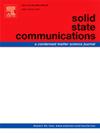Finite spin units in frustrated spin chains of Ca3Co2O6 and the induced resonant quantum magnetoelectric effect
IF 2.1
4区 物理与天体物理
Q3 PHYSICS, CONDENSED MATTER
引用次数: 0
Abstract
The subtle magnetic structure of one-dimensional frustrated Ca3Co2O6 has become a puzzling issue for a long time. The mechanism of its fractional magnetization steps also remains in debate. In this study, our experimental results demonstrate that two kinds of finite spin units (isolated Co single-ion and dimer) form in the frustrated spin chains. The quantum tunneling of the isolated Co single-ion and dimer causes the magnetization jumps around 1.2 T and 2.4 T. For the third magnetization step around μ0HS3 = 3.6 T, it can be interpreted by the field induced transition from ferrimagnetic order to ferromagnetic order. At tunneling fields, the magnetic field dependent dielectric permittivity presents obvious anomalies, implying the resonant quantum magnetoelectric coupling effect. This resonant effect was first observed in Ca3Co2O6, it supplies additional evidence for the quantum tunneling. The present work not only extends the resonant quantum magnetoelectric coupling effect to spin frustrated Ca3Co2O6, but also plots the subtle magnetic structure of Ca3Co2O6.
Ca3Co2O6受挫自旋链中的有限自旋单元及诱导共振量子磁电效应
一维受挫Ca3Co2O6的细微磁性结构长期以来一直是一个令人困惑的问题。其分数磁化步骤的机制也仍存在争议。在本研究中,我们的实验结果表明,在受挫自旋链中形成了两种有限自旋单元(孤立的Co单离子和二聚体)。孤立的Co单离子和二聚体的量子隧穿导致磁化强度在1.2 T和2.4 T附近跃迁,在μ0HS3 = 3.6 T附近的第三步磁化强度可解释为由铁磁阶向铁磁阶的场致跃迁。在隧道场中,与磁场相关的介电常数表现出明显的异常,表明存在共振量子磁电耦合效应。这种共振效应首次在Ca3Co2O6中被观察到,它为量子隧穿提供了额外的证据。本工作不仅将共振量子磁电耦合效应扩展到自旋受挫的Ca3Co2O6,而且绘制了Ca3Co2O6的细微磁性结构。
本文章由计算机程序翻译,如有差异,请以英文原文为准。
求助全文
约1分钟内获得全文
求助全文
来源期刊

Solid State Communications
物理-物理:凝聚态物理
CiteScore
3.40
自引率
4.80%
发文量
287
审稿时长
51 days
期刊介绍:
Solid State Communications is an international medium for the publication of short communications and original research articles on significant developments in condensed matter science, giving scientists immediate access to important, recently completed work. The journal publishes original experimental and theoretical research on the physical and chemical properties of solids and other condensed systems and also on their preparation. The submission of manuscripts reporting research on the basic physics of materials science and devices, as well as of state-of-the-art microstructures and nanostructures, is encouraged.
A coherent quantitative treatment emphasizing new physics is expected rather than a simple accumulation of experimental data. Consistent with these aims, the short communications should be kept concise and short, usually not longer than six printed pages. The number of figures and tables should also be kept to a minimum. Solid State Communications now also welcomes original research articles without length restrictions.
The Fast-Track section of Solid State Communications is the venue for very rapid publication of short communications on significant developments in condensed matter science. The goal is to offer the broad condensed matter community quick and immediate access to publish recently completed papers in research areas that are rapidly evolving and in which there are developments with great potential impact.
 求助内容:
求助内容: 应助结果提醒方式:
应助结果提醒方式:


